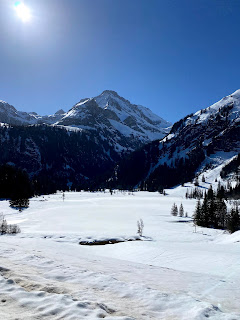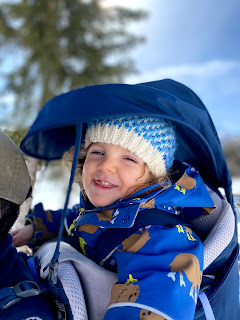Go slow in Chateau d'Oex, a pretty microcosm of Switzerland with decorative chalets, snowy mountains and satisfying strolls aplenty.
I've not yet worked out what puts the castle in Oex, but as the sun rose this morning, so too did a hot air balloon, a short distance from our balcony. It sighed as it gained height, like a whale exhaling from its blowhole. The village in the Pays d'Enhaut, between the citadel of Gruyère and the Swiss Riviera on Lake Geneva, is the hot-air-ballooning capital of Switzerland thanks to its gentle climate. It's utterly charming: a warren of wooden chalets, some dating from the 17th century, like galleys on tall ships with little windows lined up in dark walnut facades. Their balconies are intricately carved (a trademark of the region) and cauldrons hang from alcoves. Some have piles of firewood arranged under overhanging roofs.
Jagged teeth of mountains form a sort of battlements in the sky, among them La Vidamanette and Gummfluh - not large in proportion but spectacular in outline. The terrace of our Airbnb for the week looks out onto them over a patchwork of rooftops and fuzzy pine forest. Birdsong pipes all around. You can hear distant vehicles and trains, and the groan of tractors in fields. The smell of manure drifts on the air. Inside, the apartment is bright and functional, and it will do nicely.
One day, a lasso of the village brings us down to the river, La Sarine. The sun bursts over the mountaintops then rolls into the lace-like tangle of woodland, dappling the still-snowy earth. It casts highlights on branches and rushing waves. We cross an icy bridge being battered by a waterfall, before climbing to the sun-drenched slope above the village, where smart farmhouses with cheerful Easter decorations bask in wide meadows. From here we can see the length of Chateau d'Oex - from the church on its mound to the rooftop of our Airbnb on the edge of the village in La Frasse. As the sun plops out of sight, we wander into the village. Its main street features shops with intricate signage and we find a lovely boulangerie-cum-grocer's (La Consommation) where we buy locally made bread, lemon cake, and a smoked cheese from the region - l'Etivaz. That night, we watch as the full moon rises behind the mountains.
We're startled into life at Les Mosses the following day, when we become (almost) entangled with a "cross" country skier. "Faites attention!" he yells as he hurtles past. We scramble at the noise - ill suited for its purpose of making us move out of the way, it instead makes us scatter like sheep. It turns out we've missed the sign and strayed from the winter walking trail onto the cross-country loipe. Luckily we're among the only people on the high moor. Les Mosses-La Lécherette is a wide snowy plateau with dense copses and rivers twinkling between snowy banks. Its name comes from a local word meaning 'marshy area', and on this end-of-season day, the ski lifts now closed, it is tranquil.
Another short drive away, past villages that look like paper chains of chalets and the glitzy tangle of Gstaad, is the Lauenensee - a marzipan puddle basking between great hulks of snowy rock and pine forest. The day is so warm that it's a surprise to see the lake frozen, but around the edges it is starting to melt, white fusing into milky turquoise. Albie throws stones and they thump into the soft surface. It's as if I'm wearing noise-cancelling headphones; the only sounds arise when we encounter other walkers. After climbing to the lake along a woodland road, our return route follows a panoramic trail that winds between decoratively carved farmhouses and barns, eventually reaching the village of Lauenen in warm sunshine.
If we take the road that climbs up behind our apartment, following the brook, we reach the path to Rossinière. Scattered with pine cones, perfectly formed as if styled for an interiors magazine, it is hewn into the mountainside. Steep meadows tumble below, and on the horizon, there's a delight of mountains. It ducks in and out of sun-dappled woodland, passes sleepy cheese huts and meadows blooming with crocuses, and descends again beside a stream shushing as it squeezes between boulders then exhaling into translucent pools. We pass a blossom tree that appears to have an electric current passing through it: bees. Rossinière is quaint, a tangle of elegant stone houses with well-kept gardens and stucco barns with gambrel rooftops. From here, we could return to Chateau d'Oex by train (the Montreux-Oberland Bernois line passes through) but the day is so fresh and bright that we take the 40-minute walk along La Sarine and through juicy meadows. There's a stench of manure and oh, but it stinks.
As for that castle, there are the ruins of Vanel on the hillside near Rougemont, but more striking still are those bulbous balloons that rise as if towards castles in the sky. On our final morning, the mountains shimmering yellow, the Chateau d'Oex-branded hot air balloon propels gently upwards and we watch from our terrace, the crisp breeze licking our cheeks.















